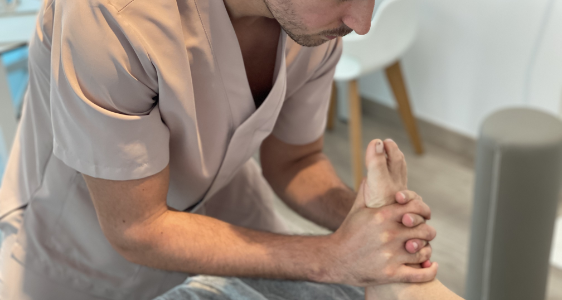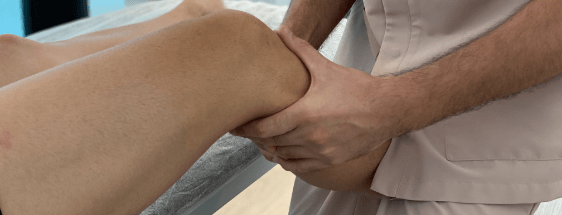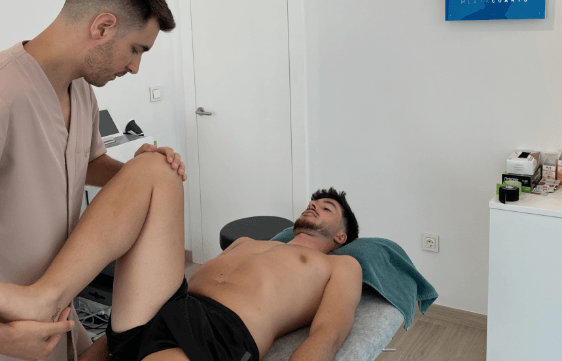
Traumatological Physiotherapy at Fisioclínica La Herradura
Prevents, treats and cures traumatic ailments such as fractures, polytraumatisms, sprains or dislocations.
Trauma physiotherapy is a discipline of physiotherapy that, through manual and physical means, prevents, treats and heals traumatic ailments such as fractures, multiple injuries, sprains or dislocations. The objective is to relieve pain, reduce inflammation, regain mobility, and achieve functional recovery of the patient.
Trauma physiotherapy deals with various pathologies such as sprains, dislocations, fractures, prostheses, torn ligaments, ruptured muscle fibers, tendon tears, meniscal pathology, osteoarthritis or arthritis.
It is common for the doctor to prescribe physical therapy sessions following a traumatic injury. At our Clinic, we are prepared to make use of these therapies thanks to the extensive experience of our physiotherapists. We always study the medical report, evaluate the person’s health, and establish a recovery program.
While each of these pathologies requires a specific assessment and treatment, the objectives will be the following:
• Ease pain
• Reduce inflammation
• Regain mobility
• Re-incorporation into activities of daily life and sports practice

The objective is to consolidate the fracture. To that end, a series of factors come into play, such as load and compression. First, we should remember that functional casts and bandages are essential to the correct treatment of fractures.
Another objective, without a doubt, is the establishment of an early treatment program that limits the effects of the immobility to which the patient will be subjected for a time.
Thus, in order to achieve joint-bone stability, a series of actions must be carried out.
Avoiding the damaging effects of immobility
One of the keys to trauma physiotherapy is avoiding the negative effects of immobility. These negative effects can be on the muscles or on the neuromuscular system, and to some degree on ligaments and cartilage tissue as well.
Evitando los efectos perjudiciales de la inmovilidad
Es una de las claves de la fisioterapia traumatológica: evitar los efectos negativos de la inmovilidad. Estos efectos negativos pueden ser sobre la musculatura o sobre el sistema neuromuscular, encontrando también algunos sobre ligamientos o sobre el tejido cartilaginoso.

• Ligament injuries: Sprains, ligament tears…
• Muscle injuries: muscle strain, muscle spasms, atrophies…
• Muscle injuries: muscle strain, muscle spasms, atrophies…
• Cartilage injuries: meniscal injuries, chondromalacia…
• Joint injuries: dislocations, partial dislocations, osteoarthritis, arthritis…
• Fractures
• Back pathologies: disc-vertebral pathology, joint subluxations, alterations in the alignment of the spine…
• Surgical injuries (preoperative preparation and postoperative recovery)
Frequently asked questions about Traumatological Physiotherapy - FAQ
What is trauma physiotherapy and when is it recommended?
Trauma physiotherapy focuses on the treatment and rehabilitation of injuries to the musculoskeletal system, such as fractures, sprains, dislocations, and post-surgical injuries.
What techniques are used in trauma physiotherapy?
A variety of techniques are employed, including manual therapy, therapeutic exercises, electrotherapy, ultrasound, and massage therapy, tailored to each patient’s specific needs.
How long does trauma physiotherapy treatment last?
The duration of treatment varies depending on the severity of the injury and the patient’s individual response. It may require anything from a few sessions to several months of rehabilitation.
Is trauma physiotherapy painful?
Some techniques may cause mild discomfort, but this is temporary and necessary for recovery.
What types of injuries are treated with trauma physiotherapy?
This discipline addresses injuries such as fractures, sprains, dislocations, ligament tears, osteoarthritis, arthritis, and other musculoskeletal conditions.
Do I need a medical referral to start trauma physiotherapy?
In many cases, a referral is not required, but having a prior diagnosis is recommended.
What should I wear to a trauma physiotherapy session?
It is advisable to wear comfortable clothing that allows easy access to the affected area to facilitate treatment.
